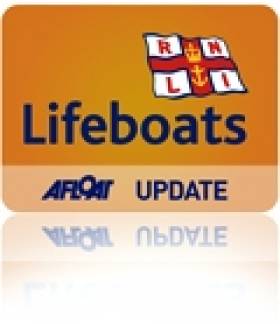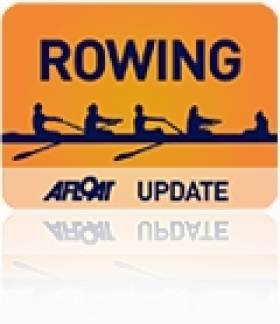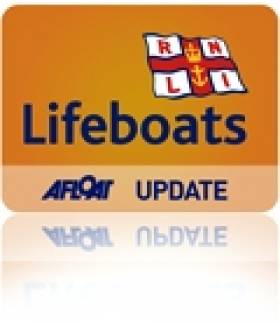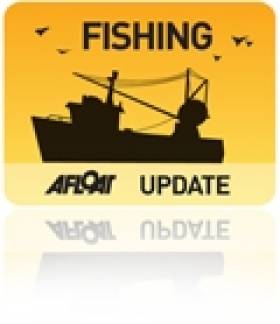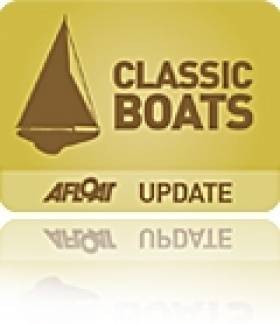Displaying items by tag: Galway
Galway Lifeboat Rescues Woman Swept Out To Sea
#RNLI - A woman was recovering in hospital in Galway last night (Wednesday 6 May) after being rescued by Galway RNLI lifeboat.
The alarm was raised by members of the public who spotted the woman in the River Corrib being swept out to sea.
They alerted the emergency services and a 'blanket' callout was made to the lifeboat, Garda, Irish Coast Guard, Galway Fire Brigade and the ambulance service at around 11.41pm.
Galway RNLI launched within minutes with helm Shane Folan and crew Dan King, Emma Hennessy and David Badger, and the woman was quickly located near waters at the Galway Enterprise Park at Galway Docks.
She was taken on board the lifeboat and brought ashore where she was transferred to a waiting ambulance and taken to University Hosptial Galway.
Galway RNLI shore crewmember John Byrne said: "The new emergency service plan for river rescues worked very well with all rescue services on the scene very quickly."
The rescue came a day after Clifden RNLI aided two lobster fishermen yesterday after their boat got into difficulty on the Connemara coastline.
At approximately 10.30am on Tuesday 5 May, Clifden RNLI's volunteer lifeboat crew was requested to launch by the Irish Coast Guard and go to the aid of two lobster fishermen in difficulty off the Aughrus peninsula.
Having experienced engine failure, the boat was drifting dangerously close to the rocks when its crew raised the alarm.
The Atlantic 85 inshore lifeboat Benjamin Downing Fairbridge was launched and was on the scene within 10 minutes of leaving shore.
Lifeboat helm Bernard Whelan and volunteer crew members Kenneth Flaherty, Joe Acton and Owen Hayes then towed the two fishermen in their boat back to Rossadillisk pier in Cleggan.
Speaking following the callout, Clifden RNLI lifeboat press officer Catherine Pryce said: "The crew responded rapidly and were delighted to be able to assist the fishermen."
Eights Wins for Galway Boys at Irish Schools Regatta
#Rowing: St Joseph’s of Galway won both the junior 16 and junior 15 boys’ eights at the Irish Schools Rowing Regatta at O’Brien’s Bridge. Another Galway school, Coláiste Iognáid, took the girls’ junior 15 eight. Presentation of Cork were the fastest crew in the men’s under-23 coxed four. There was a good spread of wins through the island of Ireland.
Irish Schools Regatta 2015, O’Brien’s Bridge, Selected Results
Men
Eight – Junior 16: 1 St Joseph’s, 2 Col Iognáid, 3 Presentation, Cork. Jun 15: 1 St Joseph’s, 2 Pres, Cork, 3 Portora.
Four – Under-23, coxed: 1 Pres, Cork, 2 St Joseph’s, 3 CBS, Cork. Junior 15, coxed: 1 St Joseph’s A, 2 Portora, 3 Presentation Cork.
Pair – Under-23: 1 Portora A, 2 St Joseph’s B, 3 Ardscoil A.
Sculling
Quadruple – Junior 16, coxed: 1 Ardscoil A, 2 Methody, 3 Killorglin. Jun 15, coxed: 1 CBC Cork A, 2 CAI, 3 Methody.
Double – Under-23: Schull CS A, 2 Marist, 3 Summerhill. Junior 16: 1 Rochestown, 2 Methody, 3 Pres, Carlow. Jun 15: 1 St Mary’s, Carlow, 2 CBC, Cork, 3 Castleknock.
Single – Under-23 (Final One, Timed): 1 Waterpark (Goff), 2 St Munchin’s (Carmody), 3 Rochestown (Larkin). (Final Two, Timed): Portora (Murray).
Women
Eight – Junior 15: 1 Col Iognáid, 2 Enniskillen
Four – Under-23: 1 Enniskillen, 2 Mount Lourdes. Jun 16, coxed: 1 Col Iognáid B, 2 Enniskillen, 3 Col Iognáid A. Jun 15, coxed: 1 Col Iognaid, 2 Mount Lourdes.
Pair – Under-23: 1 Enniskillen, 2 Laurel Hill B, 3 Laurel Hill A.
Sculling
Quadruple – Junior 16, coxed: 1 Gaelcholáiste Cheatharlach, 2 Regina Mundi, 3 St Leo’s.
Double – Under 23 (Final One, Timed): 1 St Angela’s, Cork, 2 Methody, 3 Ursuline, Sligo. Final Two, timed: Sacred Heart. Final Three, timed: St Leo’s B. Jun 16: St Dominic’s, 2 Sacred Heart, 3 Christ the King A.
Single – Under-23: 1 Gael Lmk (Murphy), 2 Christ the King (Cummins), 3 Methody (Deyermond). Jun 15 (Final One): Loreto, Fermoy (Murphy). Final Two: Loreto (McGirr).
Galway Lifeboat Assists Teenager Stranded By Rising Tide
#RNLI - Clifden RNLI certainly had a busy weekend, but more recently in Galway a 19-year-old man was rescued from an island off Silver Strand yesterday evening (Wednesday 22 April) after he was stranded by the rising tide.
A kayaker spotted the teenager in distress in an area called Grey Rock, east of Silver Strand near Barna at approximately 7.45pm, and contacted the emergency services.
Volunteers from Galway RNLI launched their inshore lifeboat from Galway Docks at 8.01pm and arrived at the area within nine minutes.
Two members of the lifeboat crew made their way onto the island and tended to the young man. They were joined in the rescue operation by Galway Garda and members of the Irish Coast Guard from Rosaveel.
The coastguard vessel took the young man and a Garda onboard and transferred them both onto the RNLI lifeboat which ferried them to Galway Docks.
- The casualty was medically examined by a lifeboat crew member at the lifeboat station at about 9.30pm. He was then transferred by ambulance to University Hospital Galway.
The lifeboat crew on this call out were helm Dara Oliver, Kieran Tolan, Daniel King and Alice Miller, and two shore crew, Olivia Byrne and Sean King. Two gardaí and five coastguard crew were also at the shore.
Elsewhere, the Lough Ree RNLI lifeboat crew received their first callout of 2015 on Saturday 18 April after a 37-foot hire cruiser ran aground on Wood Shoal, near Lecarrow.
The cruiser, which went astray of the navigation channel in mild conditions and failing light, contacted the coastguard, who then requested Lough Ree RNLI to launch at 9.22pm.
The Eric Rowse lifeboat was launched at 9.28pm and reached the grounded vessel in 20 minutes. After checking that the seven crew on board were safe and well, the boat was checked for hull damage and then towed off the rocks.
The vessel was not holed but the rudder was damaged, making steering impossible. The lifeboat crew towed the cruiser to safe moorings in Lecarrow before returning to the station.
President Opens Refurbished Galway Fishery Watchtower
#GalwayHarbour - President Michael D Higgins performed the official opening of the Fishery Watchtower Museum at Wolfe Tone Bridge in Galway city centre last Friday 24 March.
Inland Fisheries Ireland (IFI) worked in partnership with Duchas na Gaillimhe/Galway Civic Trust in revitalising the Victorian-era structure at the mouth of the River Corrib.
As owner of the tower, IFI said it was acutely aware of its responsibility to preserve the protected landmark and to ensure that safe access was provided.
The Watchtower was acquired when the Galway Fishery, popular for salmon angling, was purchased by the State in 1978.
At that time, the tower had a very practical purpose and in addition to monitoring salmon movements was also used to ensure that no untoward activity (poaching) occurred on the adjacent section of the Corrib, as well as acting as a base for a salmon draft net station. Following the purchase by the State netting of salmon ceased.
From 1997, the tower was operated by the trust as a tourist attraction and fisheries museum under a licence agreement with the WRFB, which was subsequently subsumed into IFI, and proved popular with tourists and locals alike up until the tower became inaccessible in 2007 due to deterioration in the access bridge.
With safe access to the tower no longer available, pressure came on for the bridge to be replaced, and the work of Delo Collier of the trust, in never giving up on the project, was instrumental in bringing about the provision of the new bridge and refurbishment works.
Others key to bringing the tower back to life include IFI fishery manager Seamus Hartigan and Caroline McNeill, involved in the management of the interior refurbishment.
IFI also acknowledged the support of Galway City Council throughout – in particular that provided by Kevin Swift, who worked with IFI and the trust when funding was being sought through Fáilte Ireland over a number of years to replace the bridge.
When Fáilte Ireland eventually advised in early 2012 that it could not support the project, IFI decided to proceed and fund the new bridge with some support from Galway City Council.
The old collapsed bridge, which had stood for 160 years since the tower’s construction in the mid-1800s, was removed by IFI personnel in June 2012 – not an easy undertaking given its location and dangerous condition.
The new replacement bridge was designed by local architects Simon J Kelly & Co and blends in seamlessly with the pedestrian walkway on the upstream side of Wolfe Tone Bridge, which it abuts. The new bridge was installed by Ward & Burke Construction Ltd in March 2013 and engineering and advisory services were provided by ARUP.
Following the installation of the new bridge, the trust and IFI again had easy access to the tower and work began in partnership to refurbish the building which had deteriorated over the previous number of years.
IFI is sure anyone who has the opportunity to visit the tower will be impressed with the work done, the museum exhibits and of course the unobstructed panoramic views of Galway Bay and the lower Corrib.
Since its 'unofficial' opening in late summer 2014, almost 4,000 have visited the tower, and IFI says the comments in the visitors book have been very complimentary.
The fisheries body is also sure that anyone who has the opportunity to visit – whether tourists or local Galwegians – will be impressed with the work done, the museum exhibits and the unobstructed panoramic views it affords of Galway Bay and the lower Corrib.
Picturesque Homes In Clare & Fermanagh Perfect For Anglers
#WaterfrontProperty - Two new properties on the market in Clare and Fermanagh are sure to appeal to keen anglers.
Sugarloaf on Clifden Hill in Co Clare overlooks Lake Inchiquin, described by the Irish Independent as an 'angler's paradise', and hosting a bounty of wildlife including the spectacular sea eagle.
But the picturesque spot is also a popular area for sunny-day picnics, and not only with the locals.
Sugarloaf provides a permanent picnic spot in the heart of that beautiful visa, with a detached three-bed home in 1.5 acres of gardens with panoramic views of the lake nearby and the Burren beyond.
And in spite of its privacy, with no neighbours in sight, you're just 3.5km from the village of Corofin and a swift drive further on to Ennis.
The Irish Independent has more on this property, on the market for €315,000.
North of the border, angling enthusiasts might be tempted by Amled's Fishing Lodge in Garrison, Co Fermanagh.
Within walking distance of Lough Melvin, the spacious detached five-bed home is on a secure site with high fencing, and plenty of room for boats and more in the driveway.
The wooded grounds have also been developed by the previous owner for wheelchair use, making garden maintenance easier than usual.
It's an unfinished renovation project - the upstairs is yet to be completed - but it'll be more than worth the effort to many, especially with an asking price of just £115,000 (€159,000). 4NI has more on this property.
Elsewhere, for those who just want to enjoy that seaside vibe, the Irish Independent sings the praises of Salthill in Galway.
Just a short walk from the centre of the City of the Tribes, the charming suburb maintains its own old-school seaside town atmosphere, with plenty of local social options, especially for dining.
And of course there's the renowned promenade, which hosts among others the annual An Tóstal race for Galway Hookers.
Transforming Ireland into a Pre-eminent European Sailing Nation
#irishsailing – After tweeting 'neither Afloat nor the Irish Sailing Association understand the makeup of sailors in Ireland', author Alex Blackwell gives his personal view on this week's ISA Public Meeting in Galway and on the way ahead for Irish sailing.
Sixty people from as far afield as Dun Laoghaire, from sixteen different sailing clubs, and four training centres converged on Galway Bay Sailing Club on Tuesday February 24th for the final Regional Meeting to discuss the ISA Strategic Plan 2015-2020. Chaired by GBSC's Pierce Purcell (ISA Director) and presented by Neil Murphy (ex ISA President and Chairman of the Planning Group which was operational in the final three months of 2014), the first hour was taken up with a detailed explanation of the Draft Plan, with interjections by Neil Murphy of things that have already been decided should be changed. As he put it, there were many good suggestions made at the previous two meetings, as well as in individual submissions. For the attendees, many of whom had come bearing copious notes, this often meant a reduction of what might need to be brought up.
As Neil Murphy explained, the original list of tasks had taken up over forty pages. This had been whittled down to the document at hand. Some things had been cut that should not have been. One such item was Paralympic Sailing, which as we all know has been cut by the International Paralympic Committee. This has now been reinstated in the ISA plan. It can only be hoped that the ISA will indeed take the IPC and the ISAF Disabled Sailing Committee to task on this.
The plan itself, when finalised before the end of March and voted on in the ISA Annual General Meeting on 28/03/15 in Port Laoise, will constitute the working doctrine for the ISA and its staff right through to 2020. Though 'written in stone' after the AGM, changes may of course be decided on in upcoming AGMs or EGMs.
Neil Murphy made a point of explaining that henceforth any discussion would be about "sailing" as opposed to "the sport of sailing", an issue brought up previously that the Committee felt strongly about. The understanding was that by using the term 'sport', a significant segment of the sailing and boating community was potentially excluded. It was also felt that using this term might be felt by some as elitist and infer that sailing is all about racing. Presumably since this turn of phrase is so deeply ingrained in most sailors, he then went on to almost exclusively refer to 'the sport' or 'the sport of sailing'. But there is hope.
He also brought up that, based on previous input, the ISA had started an initiative with regards to diesel fuel availability. The EU has dictated that leisure craft may only use unmarked (taxed) white diesel. However this is simply not and will not be available with the exception of mere handful of harbours, mostly in clusters around Dublin and Cork, or inland service stations which are inaccessible to visiting boats. Another issue was that the junior sailing programmes would be restructured, with greater emphasis placed on two person boats, and less on the current boat classes.
At the end of his presentation he received a warm round of applause. Almost every subsequent commentator remarked on the excellent work the committee had done in producing this document.
The ensuing discussion, during which some impassioned contributions were made, was not without some serious criticism; similar one might add to what actually happened in Cork. The first point raised was the Small Craft Register, where the ISA had suddenly folded to Government pressure without first ensuring that a working replacement was in place. This is an entirely untenable situation. Irish yachts abroad, and those wishing to go abroad are being forced to flag out to Britain, otherwise they face impoundment, either scenario being undesirable.
Another concern raised was that the stakeholders, key to the growth of sailing, had been omitted in creating a document entirely focussed on clubs, access, training, competition (racing), and culminating in the Olympics. These are the actual members and their concerns, the general public, from whom the clubs (and the ISA) draw their members, and last, but by no means least, the Government. It was pointed out that the RYA's primary focus in their manifesto is "...to ensure that legislators, regulators, and other authorities understand, and take account of, recreational boating activity." It had already been brought up in Cork that the ISA needs to be constantly in the forefront as an advocacy body in respect to sailor's freedoms and interests, and this was reiterated in Galway.
A representation was also made by another significant stakeholder group: the Sailing Businesses. Over-regulated and under-supported, these provide the goods and services all sailors and boaters need; not to mention the innovations required to advance design and technology – a 'minor detail' essential to Ireland being in the forefront of High Performance (Olympic and international class) sailing. This also includes high profile events, such as the Volvo Ocean Race, which came to Galway twice in recent years, producing two of the biggest 'sporting' events in Irish history.
A point that was raised at previous meetings and was brought up again was that the draft plan was all about racing, culminating in 'High Performance'. It was argued that racing sailors were in the minority and that this emphasis was inappropriate. According to statistics issued by the RYA (the ISA has published none) the ratio is 6-1 Club Cruisers to Club Racers. Ireland is likely similar to the UK in this regard. Another observation was that in any given club for every boat going out on the race course between five and ten remained at their mooring or in their slip. Mr. Murphy countered this contending that 60% of sailors in Ireland are racers.
A quick informal survey revealed once again that statistics can always be portrayed in a way that underpins a particular argument. Whereas most cruising boat owners who participate in club racing would consider themselves cruisers, and some racing boat owners would indeed do the same, their respective crew members (up to ten per boat), who only race and rarely have an opportunity to cruise, would almost all consider themselves racing sailors.
Perhaps we can agree that the 'Corinthian' approach would be appropriate: to promote 'sailing' and not harp on racing (as in the draft document) or cruising. We are one community with one goal. We all love sailing and wish to help promote it; be it racing around the cans, coastal cruising, adventure sailing, or simply messing about in boats. This is what needs to be reflected in the plan.
Women sailing also made for some interesting discussion between the floor and the head table. The question was raised why there were only two or three women in a room full of men. The ISA had in the past done some initiatives to get more women sailing. However, as they were implemented, these had been so far from the mark that they had in fact put women off. On the day, the women had to take the helm in a regatta without any prior experience. The 'plan' should, it was subsequently suggested, encourage comprehensive women's sailing programmes. This brought many comments about what good skippers women who actively sail do make.

The attendance at the meeting in Galway Bay Sailing Club included representatives from sixteen clubs in the west and four training centres
Class associations were also represented, and the Mirror was highlighted. Ireland's own Olympian Annalise Murphy 'honed her skills' in a Mirror Dinghy. There are countless Mirrors in sheds and garages nationwide. With the dinghy sailing focus changing to a two person boat, perhaps the clubs could bring these back out into use.
It was also pointed out that more outbound communication (PR) should be done about the high profile events taking place in Ireland, and also the fantastic people we have in the racing, cruising, and adventure sailing scenes. All of these would do a huge job in elevating the public perception of sailing in general and thus also help to promote our ambitions with high profile events like the Olympics.
The bombshell for the majority of those present, not being ISA insiders, arrived when the question of voting rights at the Annual General meeting was raised. Votes are cast en bloc by each club based on their membership (and subscription) levels. The 'Big Six' clubs on the east and south coasts, therefore carry roughly half of the votes, irrespective of who actually attends the meeting.
It is almost impossible for an individual or a small club to have any say. Intentionally or inadvertently, the "block vote" system has the effect of suppressing dissent and perpetuating the status quo. A block vote system like this was used by the trades unions to control the British Labour Party until it was abolished in 1994 in favour of one member, one vote.
Small wonder then, that the smaller clubs, which are the majority of the clubs in the rest of the country, continue to feel under supported and under represented by the ISA. As the main mission of ISA must be to serve its members and to grow interest and participation in sailing in all its forms, the strategic plan must be broadened to encompass all the representative points of view.
Alex Blackwell is an author and sailor who lives on the shores of Clew Bay in County Mayo where he bases his Bowman 57 Aleria.
Man Convicted for Illegal Fishing in Galway
At a sitting of Galway District Court on Monday, 23rd February, Judge Aeneas McCarthy convicted a man living in Galway on two counts of illegal fishing, and issued fines of €450.
Vyaceslav Kovalcuks, with an address at Cnoc an Oir, Rahoon, Galway, was charged with: use of a scheduled engine, in this case a longline; fishing with live bait; use of more than two rods; and with refusing to give his name and address, in contravention of fisheries legislation.
Judge McCarthy heard evidence that on the morning of 24th April 2014, Mr. Kovalcuks was observed by fishery officers fishing in a small rubber dinghy on Ballyquirke Lake, Moycullen. He was seen fishing with a longline baited with live fish, and also had three small rods out with which he was catching small coarse fish to use as bait. When he came ashore he was approached by fishery officers but refused to give his name and address, which he continued to refuse until Gardai were called.
Judge McCarthy convicted Mr. Kovalcuks on two counts, with the other charges taken into account. Mr. Kovalcuks was fined €300 for the use of a scheduled engine, and €150 for the use of live bait. Costs of €600 were also awarded.
Inland Fisheries Ireland (IFI) has a confidential hotline number to enable members of the general public to report incidents - 1890 34 74 24 or 1890 FISH 24. This phone line is designed to encourage the reporting of incidents of illegal fishing, water pollution and invasive species.
Galway Skipper Expo 2015 Set To Be Biggest & Best Yet
#Fishing - Over 110 companies will be exhibiting at Skipper Expo International Galway 2015 on 6-7 March.
This is the event's biggest exhibitor attendance ever – and organisers say it's confirmation of the important place the flagship fisheries show holds in the industry calendar.
Sponsored by Bord Iascaigh Mhara (BIM), this year’s 11th anniversary Galway event in Ireland is shaping up to be the best yet, thanks to the huge amount of interest from both exhibitors and visitors from all over Ireland, the UK and beyond.
Indeed, such has been the demand for stand space that two additional rooms have been secured at the event venue at the Galway Bay Hotel to accommodate this extra surge in interest.
Star attractions will include boat displays, pool demos and the superb exhibitors’ seafood buffet. There will be something to interest every visitor, thanks to the vast range equipment and service suppliers covering all sectors of the fishing industry.
Sharon Boyle of show organisers Mara Media said: “We have been overwhelmed by the huge interest in Skipper Expo International Galway 2015 and it promises to be a fantastic event. The record number of exhibitors underlines the dynamism and innovation that lies at the heart of our fishing industry.”
Skipper Expo 2015 opens on Friday 6 March at 10am running till 5pm, continuing on Saturday 7 March from 10am to 4pm. Admission is free, and more details can be found at the Mara Media website HERE.
Canadians Lobby To Keep 'Grandfather Canoe' Amid Ownership Fears
#HistoricBoats - A Canadian community descended from the builders of the world's oldest birchbark canoe have expressed concern that the vessel may be returned to Ireland, according to The Irish Times.
As previously reported on Afloat.ie, the 'Grandfather Canoe', or Akwiten, was crafted by the Mailseet First Nation in Canada's Maritimes for use on the St John River valley in New Brunswick under British colonial rule almost 200 years ago.
A programme for RTÉ Radio's Documentary on One strand in August explained how the canoe later passed into the ownership of British army captain Stepney St George, who took it home to Headford Castle, from where it was later bequeathed to NUI Galway.
In the 2000s the canoe was rediscovered and after a First Nations campaign, in 2009 it was repatriated and presented to the Beaverbrook art gallery in New Brunswick, where it is presently in storage without exhibition space.
It has lately emerged that the historic vessel's current ownership status is unclear, prompting fears that it may be sent back to the City of the Tribes.
Members of the Mailseet community are now lobbying for the right to care for and exhibit what is a "spiritual and cultural artefact" to their people.
The Irish Times has more on the story HERE.


























